The 7th International Seminar on Biodiversity and Evolution: Genetic and hormonal analyses on wild animals
第7回 生物多様性と進化に関する国際セミナー:野生動物における遺伝とホルモンの解析Introduction
One of our central isssues is conservation of biodiversity and its evolutionary understanding. Focusing on this issue, we have held international seminars since 2012, with young researches from foreign countries.In the present seminar, we introduce recent approaches on the study of wild animals. We also present recent achievement by invited foreign young students, and the results of the "Field Biology Course", held just before this seminar.
We hope this seminar help mutual understanding between students from foreign countries, especially with rich wildlife, and Japanese researchers and future international collaborations.
Date and Venue
November 20, 201713:00-18:00
Science Seminar House, North Campus of Yoshida Campus, Kyoto University
京都大学北部キャンパス 理学研究科セミナーハウス
Map of Kyoto University (English), No.10 building on this map
Map of Kyoto University (Japanese), No.10 building on this map
Contact
e-mail: cetbio7@wrc.kyoto-u.ac.jp
Program
13:00-13:10 Opening remarks
Shiro KOHSHIMA (Wildlife Research Center, Kyoto university)
Session 1: Recent achievement by invited foreign students
Chair: Hideki SUGIURA (Wildlife Research Center, Kyoto university)
13:10-13:20 Zoe Melvin (Institute of Cognitive and Evolutionary Anthropology, University of Oxford)
Socio-ecological characterisation of the putative primate hybrid zone between Papio cynocephalus and Papio ursinus at Gorongosa, Mozambique
13:20-13:30 Ahmad Abdul Jabbar (Science and Mathematics, Bogor Agricultural University)
Environmental DNA Metabarcoding to Detect Threatened Mammals Species at Natural Salt-licks in Tropical Rain Forest Ecosystem of Northern Sulawesi, Indonesia
13:30-13:40 Ekta Chaudhary (Centre for Ecological Sciences, Indian Institute of Science)
Large herbivore dung decomposition in Indian tropical Forest: implications for nutrient cycling
13:40-13:50 Angélica Nunes (National Institute of Amazonian Research)
Impacts of fisheries on river dolphins in the Amazon
13:50-14:00 Evyen Wevan Jebrail (Institute For Tropical Biology and Conservation, Universiti Malaysia Sabah)
The Effects of progressive land use changes on the distribution, abundance & behavior of vector mosquitoes in Sabah, Malaysia
14:00-14:10 Hao Jing (School of Sociology and Anthropology, Sun Yat - sen University)
Using Social Network Technology to Analyze the Spread of Traditional Ecological Knowledge
Session 2: Genetic analyses on wild animals
Chair: Takushi KISHIDA (Wildlife Research Center, Kyoto university)
14:10-14:45 Yoshi KAWAMOTO (Primate Research Institute, Kyoto university)
Conservation Genetics of the Japanese Macaque: Toward the Conservation and Management of the Local Population
14:45-15:00 Break
15:00-15:15 Takushi KISHIDA (Wildlife Research Center, Kyoto university)
Genetic diversity and distribution of mitochondrial DNA haplotypes in the Yakushima Japanese macaques in 2017: an update of a phylogeographic study reported in 2006.
15:15-15:35 Kei MATSUSHIMA (Wildlife Research Center, Kyoto university)
Monitoring terrestrial mammals using environmental DNA: a case study on Kamo River
Session 3: Hormonal analyses on wild animals
Chair: Kodzue KINOSHITA (Wildlife Research Center, Kyoto university)
15:35-16:10 Yojiro YANAGAWA (Faculty of Veterinary Medicine, Hokkaido University)
Is it possible to estimate partial population structure from fecal hormone analysis in Hokkaido sika deer?
16:10-16:30 Kodzue KINOSHITA (Wildlife Research Center, Kyoto university)
Endocrinological characteristic of Yaku Sika Deer
16:30-16:40 Break and prepapation for poster presentation
Session 4: Poster presentation
16:40-17:55
Yoshimi Agetsuma-Yanagihara (Waku Doki Science Planning)
How do deer achieve foraging success under intraspecific competition for food dropped by foraging macaques?
Mina Jimbo (Graduate School of Environmental Science, Hokkaido University)
Diet of harbour seal (Phoca vitulina) in Erimo, Hokkaido: Using DNA metabarcoding diet analysis
Takafumi Suzumura (Wildlife Research Center, Kyoto University)
Demographic data of wild Japanese monkeys on Koshima Island: preliminary analysis of the period 1952 - 2009
Deer team of Yakushima Field Science Course, Fall, 2017
Behavior and Sex Hormone Concentrations of Wild Yaku Sika Deer
Monkey team of Yakushima Field Science Course, Fall, 2017
Regional Distribution of mtDNA Haplotypes in Yakushima Macaques (Macaca fuscata yakui)
Hideki Sugiura (Wildlife Research Center, Kyoto University)
Survey of camphor plantation by drone
Banquet
18:30-
Wildlife Research Center
Map (English)
Map (Japanese)
Fee: 500-1000 yen for permanent staff
Free for students and part-time staff
Registration
No registration is required in advance.Please write your name and affiliation at the entrance.
Abstracts
Zoe Melvin1 & Paleo-Primate Project Gorongosa1,2
1Primate Models for Behavioural Evolution Lab, Institute of Cognitive and Evolutionary Anthropology, University of Oxford, 2Gorongosa National Park, Sofala, Mozambique
Socio-ecological characterisation of the putative primate hybrid zone between Papio cynocephalus and Papio ursinus at Gorongosa, Mozambique
I am currently working as a Research Assistant for the Paleo-Primate Project Gorongosa which is a long-term project using an integrative approach to investigate human origins and adaptations. The project is based in Gorongosa National Park, located at the final southern termination of the East African Rift System (EARS) in Mozambique. This portion of the Rift also known as the Urema Rift, also coincides in location with one of the most ecologically diverse ecosystems on Earth. One of the project aims is to establish the first long-term primatological site for the study of the genus Papio in Mozambique, focusing on the unknown Baboons of the Urema Rift. A number of projects focusing on the genetics and behavioural ecology of the ca. 225 troops of baboons ranging in this highly complex ecosystem are being used as models for understanding hominin origins and adaptations to similarly complex environments. To do this, we are combining palaeoanthropological approaches to directly study human and faunal paleontology, with genetic techniques to understand potential hybridization processes in primates, and the evolutionary history of the Gorongosa baboons. My research focuses on the behaviour and genetics of this unstudied population which is suspected to be a hybrid between Papio ursinus and P. cynocephalus. I am interested in finding the limits of the potential hybrid zone, the ecological and biological influences on hybridisation and the outcome of hybridisation. Previous research has shown that hybrids in other baboon zones have shown intermediate levels of behaviour between the parental taxa. I am interested in how this may affect fitness and therefore perpetuation of the hybrid zone. I aim to utilise genomic methods to characterise the putative hybrid zone and, by placing the results in a behavioural and ecological context, to understand the dynamics of the hybrid zone over time.
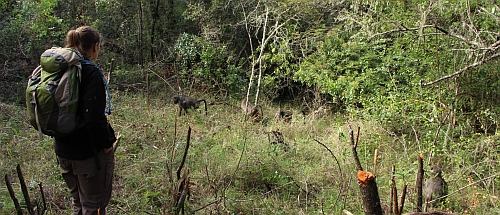
Ahmad Abdul Jabbar1
1 Science and Mathematics, Bogor Agricultural University
Species detection is necessary in preserving threatened mammals population. Traditional methods to detect mammals presence are often invasive, inefficient, environmentally destructive, or resource‐intensive. The number of studies demonstrating successful of environmental DNA (eDNA) approach in detection of wildlife has increased rapidly in recent years. Metabarcoding of environmental DNA offers a new means to assess mammals diversity in tropical rain forest, but adoption of this approach for this ecosystem is still lack. Terrestrial mammals reported have frequent contact with natural salt-licks to meet its dietary needs, implying that environmental DNA originating from those mammals should be detectable from this place. Aiming to detect the presence of terrestrial mammals using natural salt-licks water samples, we have been conducting a metabarcoding eDNA method. We had collected ten 400 ml water samples from natural salt-licks in Adudu, Nantu Natural Reserve, Gorontalo, Northern Sulawesi. Based on the versatility of MiMammal primers were reported and tested in other previous study, we had extracted the eDNA. Amplicon libraries are going to be constructed using extracted eDNA and sequences are going to be generated by Illumina MiSeq are subjected to data processing and taxonomic assignment.
Ekta Chaudhary 1
1 Centre for Ecological Sciences, Indian Institute of Science, Bangalore, India
Large herbivore dung decomposition in Indian tropical Forest: implications for nutrient cycling
My PhD thesis is an attempt to deconstruct the contribution of large herbivores such as elephant, and gaur, to soil nutrient pool in a dry tropical forest. This study will enable us to calculate the flux of nutrients from large herbivores in a tropical ecosystems. We address three primary questions in this study- What are the soil macrofauna communities involved in the cycling nutrients from herbivore dung to soil; How is the decomposition activity of soil macrofauna affected by various abiotic and biotic factors; What is the final impact of herbivore dung to soil nutrient pool. These questions have been answered with a combination of various field in-situ and ex-situ experiments coupled with laboratory based chemical analysis
Angélica Nunes1, 2
1 MSc. em Ecologia - Instituto Nacional de Pesquisas da Amazônia Laboratório de Mamíferos Aquáticos - LMA, 2 Laboratório de Biologia Evolutiva e Comportamento Animal - LABECA
Impacts of fisheries on river dolphins in the Amazon
The dolphins that inhabit fluvial environments are considered the most threatened cetaceans, since they occur in areas of high human occupation where the conflicts and anthropic pressure on the natural resources are more intense. Since the year 2000, Amazon dolphins have been killed for use as bait in piracatinga (Calophysus macropterus) fishing. Although recent, this activity presents worrying figures regarding the mortality of porpoises and due to this, the Brazilian Government has stipulated a moratorium that prohibits the fishing and commercialization of this fish throughout the national territory. However, the inspection of this fish is hampered by the fact that it is sold in the form of a filet and under a fancy name. To provide support material to inspectors, we developed a method of visual identification of piracatinga fillets. By means of visual identification, inspectors can effectively investigate the presence of piracatinga among the fish benefited and marketed in the slaughterhouses and markets of the region, thus proving the effectiveness of compliance with the moratorium.
Evyen Wevan Jebrail1
1 Institute For Tropical Biology and Conservation, Universiti Malaysia Sabah
The Effects of progressive land use changes on the distribution, abundance & behavior of vector mosquitoes in Sabah, Malaysia
Malaria is still a serious vector-borne disease in Sabah (Vythilingam et al., 2005). However, little is known about the impact of land use changes due to agroforestry practices on this disease. It has been known that, among other factors, agricultural activities can influence the transmission of malaria (Koudou et al., 2009). Information on the abundance and behavior of the vector mosquitoes in newly opened areas are not yet available. Thus, Vythilingam et al. (2005) suggested that further studies should be carried out to determine the status of Anopheles donaldi as a vector in Sabah since in a study conducted in 2001-2003, it is found that Anopheles donaldi is predominant species & positive for sporozoites. The specific objectives of this study are to investigate the effects of progressive land use changes from pre-development forest & through forest clearing on occurrence of vector mosquitoes, to determine the status of Anopheles donaldi as a vector in changing land uses and lastly, to study the seasonality, abundance and behavior of vector mosquitoes in study sites. Study areas are located at logged forest and block B in SAFE Project, Kalabakan and Maliau Basin Conservation Centre.
Collector will spend 2 nights at each study site to collect mosquitoes where all-night human landing collection will be carried out at 3 different sampling points. Collector will perform outdoor landing catches from 18:00 to 00:00 (Chang et al., 1997). Collected mosquitoes will be morphologically identified the next morning before they’re dissected to inspect whether they’re carrying sporozoites or not. In every sampling period, meteorological data such as air temperature, relative humidity, atmospheric pressure and wind speed will be recorded on hourly basis by using a handheld weather station. Immature stages of mosquitoes will be sampled in potential breeding sites such as streams, ground pools, ditches and swamp.
Hao Jing1
1 School of Sociology and Anthropology, Sun Yat - sen University
Since Barnes put forward the concept of social network analysis, social network analysis has been clear concept, update technology. Until today, social network analysis has evolved into a technology-based methodology. As a kind of applied research method in the field of sociology, social network analysis has played a role in promoting the development of sociology and anthropology. Social network analysis has long been crossed the boundaries of disciplines, and applied to sociology, anthropology, behavior and other disciplines, and is widely used in practical research. From the perspective of anthropological disciplines, social network analysis of the relationship is often those who link the relationship, but some important social relations may also, such as apes, orangutans and some other non-human individuals linked. As we all know, China is a multi-ethnic country. Every people of the ethnic have their own traditional ecological knowledge of the environment. The future of China can not continue to the old road witch mean “first contaminated and then treated”, but to break through the traditional development model, to achieve ecological environment, economic, social and cultural sustainable development, take the green development path. Therefore, in the field of ecological anthropology, the use of ecological anthropology theory and social network analysis techniques to study the traditional ecological knowledge of the spread of ethnic minority areas, has great practical significance and theoretical significance. Guangxi Zhuang Autonomous Region has a unique natural environment in the green development process and save a more intact national culture. And they have a sense of protecting the local animals and ecology. Therefore, we need to use the technology of social network analysis to find the traditional ecological knowledge of Guangxi transmission path, and then provide practical examples for China's green development.
Yoshi Kawamoto1
1 Primate Research Institute, Kyoto University
Conservation Genetics of the Japanese Macaque: Toward the Conservation and Management of the Local Population
Revision of National Wildlife Law in 2015 is accelerating damage control in Japan by reducing population size for deer and wild boars. This is also the case in Japanese macaques. Primatologists are requested to provide reasons and evidences to consider the priority to which local population should be remained in the future management program. It is important to investigate the relationships among “evolutionary (historical) background”, “genetic continuity (or gene flow)” and “geographical continuity” of populations towards definition of units for future conservation and management of the species. I and my colleagues have studied the relationships based on population genetic analyses of mitochondrial DNA (mtDNA) and nuclear DNA. In the assessment of population history, we use a Bayesian method of phylogenetic tree analysis that is implemented in the software BEAST. Comparing nucleotide sequences of mtDNA non-coding region (939 bp) for 145 groups, we evaluated the time of most recent common ancestor (MRCA) for local populations. The results depicted chronological changes in the establishment of local populations of the species.
Genetic continuity that reflected gene exchange between geographically defined populations was evaluated by multi-locus genotyping of STR (nuclear short tandem repeat). Local population was operationally defined by the method of Koganezawa (1995) that took geographical continuity of group habitats into consideration. A total of 32 representative samples were selected from each population unit. Genotyping was routinely performed for a set of 16 autosomal STR loci. Genetic continuity between unit populations were evaluated by the software STRUCTURE in which obtained genotypes were used to assign individuals into local populations. The degree of gene flow was quantified in terms of effective number of migrants between populations per generation (Nm). This number was estimated from FST, a relative index of population differentiation obtained from STR data.
I will introduce the results of on-going study and discuss the applicability of above methods toward the conservation and management of primate populations in Japan. This study is also deeply related to the procedure how to monitor biological changes in local populations under control in law.
Key words: Japanese macaque, population history, population structure, mtDNA, STR, conservation genetics
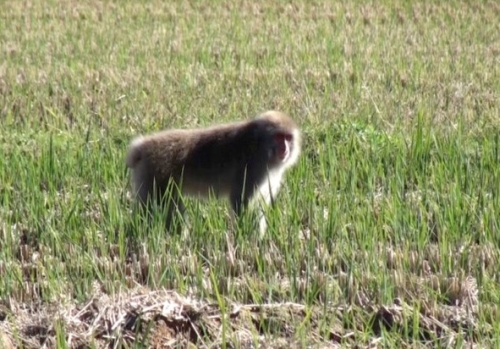
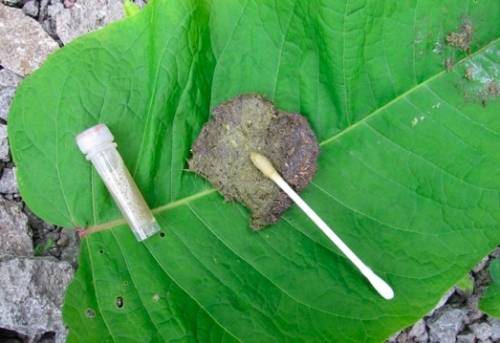
For more graphic material of the paper, see PDF (1.2 MB)
Takushi Kishida1, Kei Matsushima1, Moe Yanagi1, Taku Otsubo2, Mikaze Kawada3, Christopher Chai Thiam Wong4
1 Wildlife Research Centre of Kyoto University, 2 Dept. of Botany, Kyoto University, 3 Dept. of Zoology, Kyoto University, 4 WWF-Malaysia
Genetic diversity and distribution of mitochondrial DNA haplotypes in the Yakushima Japanese macaques in 2017: an update of a phylogeographic study reported in 2006.
The Yakushima Japanese macaques Macaca fuscata yakui are an endemic subspecies of Yakushima Island. Using feces collected by members of the Genome Science Course held in May 2017, the phylogeography of Yakushima macaques is investigated based on the mitchondrial DNA (mtDNA). The mtDNA-based phylogeography of the Yakushima macaques was primarily reported by Hayaishi and Kawamoto in 2006. They found 6 haplotypes of the mtDNA among Yakushima macaques and reported the distribution of these haplotypes. We also found all these 6 haplotypes, but the distribution pattern of these haplotypes is changed. This may reflect the movement of Yakushima macaque population during the last decade.
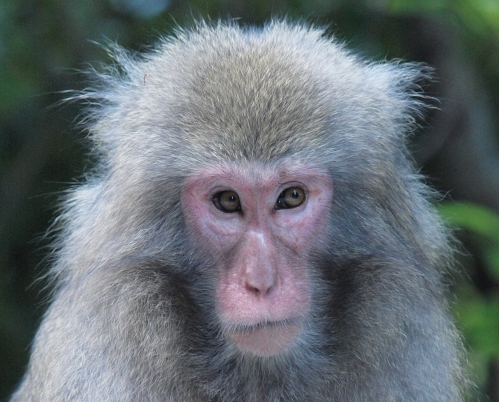
Photo: Hideki Sugiura
Kei Matsushima, Takushi Kishida1
1 Wildlife Research Center of Kyoto University
Monitoring terrestrial mammals using environmental DNA: a case study on Kamo River
Wildlife monitoring is important for conservation of endangered animals. Traditionally, physical identification methods, i.e. camera trapping or direct observation, are used for this purpose. But in some cases, it is difficult to identify the species or to survey. Environmental DNA (eDNA) analysis is high sensitivity and cost-effective method, although there are still some problems in some respects. I will show the advantages and challenges with the result of eDNA analysis on water samples of the Kamo River.
Yojiro Yanagawa1
1 Faculty of Veterinary Medicine, Hokkaido University
Is it possible to estimate partial population structure from fecal hormone analysis in Hokkaido sika deer?
For the appropriate management of Hokkaido sika deer (Cervus nippon yesoensis), population size and structure need to be estimated by the available data. One factor influences to the population dynamics is proportion of fawn. Usually these data are obtained from direct observation i.e. census or hunting data, those are not always expected as accurate and moreover time consuming. If there are more convenient and accurate methods, it is much valuable for further management. In Hokkaido sika deer, it is known that most of the animals become sexually maturated at one year old for both sex, so that mean proportion of fawn can be replaced by proportion of non-sexually matured animals. Fecal sample is the indirect source of animal condition and fecal steroid hormone is usually used for monitoring and estimating the reproductive status of the animal. The present study is preliminary trial to estimate the proportion of immature animal in the population by measuring fecal steroid hormone.
The total of 148 feces sample (35 fawn, 113 adults) were collected from female sika deer throughout the year, and then fecal progesterone and estradiol concentration were measured. The year was separated in four periods; early-pregnancy (Jan-Mar), late-pregnancy (Apr-Jun), non-breeding (Jul-Sep), and breeding (Oct-Dec). Both steroid hormones were compared between fawn and adult in each periods, and data showed significant difference submitted to ROC analysis. For distinguishing fawn, progesterone concentrations in early-pregnancy period were appeared to be most appropriate and the cutoff vale was 286.3 ng/g. By measuring fecal steroid hormone concentration, it is may be possible to estimate the population structure.
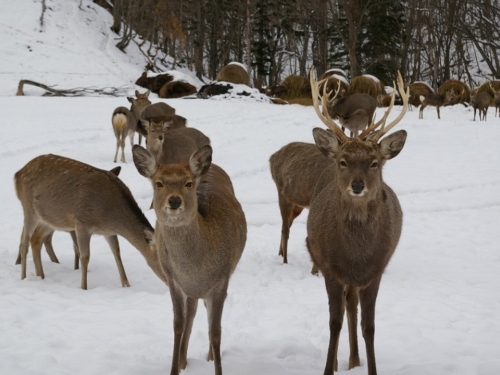
Kodzue Kinoshita1, Yoshimi Agetsuma-Yanagihara2, Naoki Agetsuma3, Hideki Sugiura1, Goro Hanya4, Takashi Hayakawa4, Yojiro Yanagawa5
1 Wildlife Research Center, Kyoto University, 2 Waku Doki Science Planning, 3 Field Science Center for Northern Biosphere, Hokkaido University, 4 Primate Research Institute, Kyoto University, 5 Faculty of Veterinary Medicine, Hokkaido University
Endocrinological characteristic of Yaku Sika Deer
Yaku sika deer (Cervus nippon yakushimae) is one of subspecies of Japanese deer, which inhabits the farthest southern in Japan. Their endocrinological characteristic has never been studied on. In this study, to elucidate their breeding physiology, their feces were collected from several wild Yaku sika deer to monitor sex steroid hormone concentrations. In addition, we measured sex steroid hormone concentrations of another subspecies, Hokkaido sika deer (C. n. Yesoensis), which inhabits the farthest northern in Japan, to clarify the difference between Yaku sika deer and Hokkaido sika deer.
From the results of sex steroid hormone concentrations, it was found that estrogen and testosterone concentrations were similar between the two subspecies. However, with regard to the sex maturation, it was suggested that Hokkaido sika deer mature over 1 year old and that of Yaku sika deer mature over 3 years old. As for progesterone in Yaku sika deer, high concentrations were also detected in males and females under 3 years old, which never get pregnant, as well as mature females aged over 3 years. Such results were not obtained in Hokkaido sika deer. It was suggested that one of the reasons for this is the fact that Yaku sika deer eats the feces of Yakushima Japanese macaques (Macaca fuscata yakui), which has the same breeding season as Yaku sika deer. This will be verified by measurement of fecal steroid hormone concentration in captive animals, which has never eaten the macaque feces.
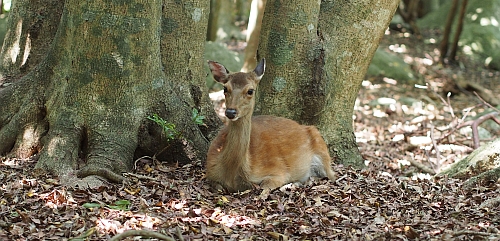
Yoshimi Agetsuma-Yanagihara1, Naoki Agetsuma2
1 Waku Doki Science Planning, 2 Field Science Center for Northern Biosphere, Hokkaido University
How do deer achieve foraging success under intraspecific competition for food dropped by foraging macaques?
In an warm temperate forest of Yakushima, Japan, Yaku sika deer (Cervus nippon yakushimae) often gather under trees to obtain food dropped by foraging Yakushima macaques (Macaca fuscata yakui) in the branches above. We defined areas under the food trees as macaque-food patches (MFPs). In MFPs, agonistic interactions frequently occur for food among the deer. Thus, the deer develop foraging strategies to acquire food and counter intraspecific competition in MFPs. Their ability to compete varies among the age-sex classes. In addition, the condition of the dropped foods can be classified into two types (L-type, cluster of fruits and leaves attached to a branch; S-type, individual fruit and leaf dispersed over MFPs). Therefore, we predicted that their foraging strategy changes with the age-sex class and food type. We recorded residence time, food intake, and agonistic interactions of deer in MFPs. Agonistic interactions occurred more frequently in L-type MFPs than S-type MFPs. Adult males tended to stay in L-type MFPs for a longer period, frequently attack other deer, and achieve higher food intake speed. Young males also tended to stay for a longer period; however, they were frequently attacked, and they achieved middle food intake speed. Adult and young females tended to stay for a shorter period, were frequently attacked; however, adult females also tended to attack frequently. Further, adult females achieved lower food intake speed, although young females could obtain little food. The deer in MFPs appeared to apply different foraging strategies corresponding to their age-sex classes.

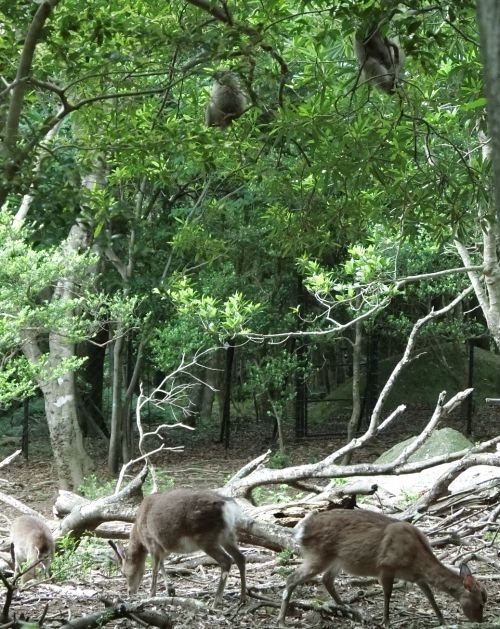
Mina Jimbo1, Yuki F. Kita2, Mari Kobayashi3, Yoko Mitani4
1 Graduate School of Environmental Science, Hokkaido University, 2 School of Biological Science, Tokai University, 3 Faculty of Bioindustry, Tokyo University of Agriculture, 4 Field Science Center for Northern Biosphere, Hokkaido University
Diet of harbour seal (Phoca vitulina) in Erimo, Hokkaido: Using DNA metabarcoding diet analysis
Competition between humans and the pinnipeds for economically valuable fish resources in the coastal areas of Hokkaido has become serious problem in recent years. Thus, understanding the predation pressure by the pinnipeds is important in terms of resource management of catch target species. Harbour seals (Phoca vitulina) are staying annually in the rock reef area in Erimo, Hokkaido. They are the opportunist predators which occasionally feed on abundant species non-selectively. In this study, we aimed to understand what harbour seals forage during fishing season in Erimo.
The colon contents of seals who caught and deceased by set net for salmon in Erimo during spring and fall 2013–2017 were sampled. Feed derived mitochondrial COI gene was obtained by PCR and amplicon sequencing (MiSeq, Illumina) from the colon contents.
The number of detected prey species was 19 from spring samples (n=38) and 25 from fall samples (n=49). Prey species were gathered for each taxonomic group, and the frequency of occurrence (FO) of octopuses, greenlings and squids were over 60% in spring and 40% in fall. They prey mainly octopuses, greenlings and squids throughout the year. The diet of adults and pups were similar because they forage together in spring. However, pups forage various prey species respectively in fall. Not all seals entering salmon set net constantly eat salmon but large adult seals habitually eat salmon. These results are important knowledge in management of seals, such as consideration of predation pressure of fishery target or selective exclusion of salmon feeders.
Zefang Xu1, 2, Sota Inoue2, Maegan Fitzgerald2, Li Weidong1, 2, Hao Jing1, 2, Evyen Wevan3, Ekta Chaudhary4 (participants)
Yoshimi Yanagihara5, Naoki Agetsuma6, Mari Nishikawa2, Kodzue Kinoshita2 (instructors)
1 Sun Yat - sen University, 2 Kyoto University, 3 Universiti Malaysia Sabah, 4 Indian Institute of Science, 5 Waku Doki Science Planning, 6 Hokkaido University
Behavior and Sex Hormone Concentrations of Wild Yaku Sika Deer
Yaku sika deers are a smaller sub species of Japanese Sika Deer. There are about 20,000 individuals on Yakushima Island. Most of our insight to sika deer behavior and physiology comes from white tailed deers and red deers. Therefore, the primary goal of this study was to understand behavior and hormone dynamics of Yaku sika deers. We collected behavioral data and fecal samples over a week time and examined the relationship between mating behavior and sex steroid hormone concentrations.
In this study, we recorded various interactions between male and female Sika deer, as well as between same sexes. Deer behavior such as feeding, grooming, moving etc. were observed for two hours with four minutes intervals and their social behavior was also recorded. During the behavioral observation, their feces were also collected to analyze different sex steroid hormones (testosterone, estradiol-17β, and progesterone). In laboratory we extracted sex steroid hormones from the feces using ethanol and the concentrations of the hormones were measured using Enzyme-Immunoassay (EIA).
Mating seems to be the most commonly observed male behaviour, females mostly showed affiliative behaviour by spending most of time with their calves. Heightened male mating behaviour is usually associated with higher concentrations of testosterone. Yet, female mating behaviour is low until December, at which point female Estrogen levels also increase. The mean estrogen and progesterone concentrations for each sex class are not significantly different (p > 0.05). For testosterone, there is a significant difference in the mean concentration between mature females and males, but there is no significant difference between immature deer and mature deer of either sex. Examination of the hormone levels revealed that AM10 had high levels of Testosterone, faeces from AM2 had a testosterone concentration close to average. Our behavioural observations may not have been comprehensive enough to draw conclusions on behaviours influence, or lack thereof, on hormone concentrations and vice versa.
Ahmad A Jabbar1, Angelica Nunes2, He Tianmeng3, Hao Jing4, Louie Nigh3, Sara Coronado5, Yayan Kusuma6, Zoe Melvin7
1 Bogor Agricultural University, Indonesia, 2 Aquatic Mammals Lab, National Institute of Amazonian Research, Brazil, 3 Primate Research Institute, Kyoto University, Japan, 4 School of Sociology and Anthropology, Sun Yat-sen University, China, 5 Graduate School of Science, Kyoto University, Japan, 6 Graduate School of Agriculture, Kyoto University, Japan, 7 Institute of Cognitive and Evolutionary Anthropology, University of Oxford, UK
Regional Distribution of mtDNA Haplotypes in Yakushima Macaques (Macaca fuscata yakui)
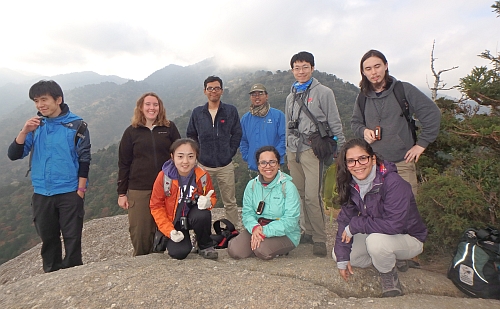
T. Suzumura, H. Sugiura, T. Matsuzawa, G. Idani1
1 Kyoto University
Demographic data of wild Japanese monkeys on Koshima Island: preliminary analysis of the period 1952 - 2009
This paper summarizes demographic data from a troop of wild Japanese monkeys on Koshima island. The island measures about 32 ha, with a maximum elevation of 113 m, and is covered by semi-tropical forest. Imanishi and his colleagues began the long-term observation of Koshima monkeys on December 3, 1948. Since then, researchers have been provisioning and habituating monkeys, and continuously collecting demographic data and monthly body weight measurements from individual troop members. Currently, longitudinal records span eight generations of monkeys. During the 57-year period from 1952 to 2009, a total of 558 individual monkeys have been recorded: 290 males, 241 females, and 27 infants who died and disappeared before their sex could be determined. Therefore, the male to female sex ratio was 1.20. The body weight of males reached its maximum between the ages of 12 to 14 years (12-13 kg); in females maximum body weight was recorded between 7 to 8 years (6 to 8 kg). Individuals in this troop are thus smaller than average wild Japanese monkeys. The average age at which females first gave birth was 8.49 years, based on records from 128 individuals. Among these females, the average number of births per individual was 4.29. Infant mortality rate within the first year of life was 33.1% among male offspring and 29.2% among females. Further analysis has revealed differences in demographic parameters among family lineages.
Survey of camphor plantation by drone1
1 Wildlife Research Center, Kyoto University
I report an attempt of survey of planted camphor trees by taking pictures from a drone. I flew a drone in Segire area, western lowland on Yakushima Island.
Camphor have been used for several purposes, such as medicine, insect repellent and material of celluloid. In this area, camphor trees occur in exceptionally high density, which are likely to be planted artificially. The area of camphor trees are distinctive with its round shape, yellowish leaf color and unique texture. Total area of camphor trees was 37,415 m2 (3.7 ha). About 30 % of the relatively flat land of this area was occupied by planted camphor. I could not discriminate some area with confidence. Additional survey from the ground should be necessary for more exact discrimination. Ground and aerial surveys are complimentary each other.
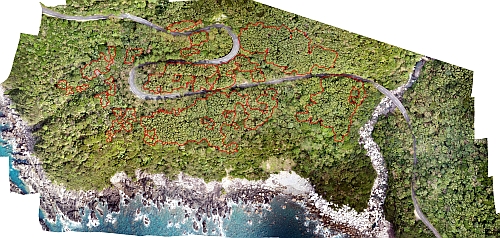
Cosponsored by:
MEXT Leading Graduate School Doctoral Program, "Leading Graduate Program in Primatology and Wildlife Science"
JSPS Core-to-Core Program, A. Advanced Research Networks, “Tropical Biodiversity Conservation”
